My first week in La Paz has left me breathless. Quite literally. At nearly 12,000 feet (3600 m), La Paz is the highest capital in the world. The lower-altitude Sucre remains the official capital, but La Paz is the de facto power center in the country housing both the executive and legislative branches of government.
The magnificence of the setting is striking: the towering Andean peaks of the Cordillera Real to the east, crowned by Mount Illimani which soars to over 22,000 feet (6465 m). The dense city center flows downwards through the canon along the mostly covered Choqueyapu River.
The wealth of the residents increases as altitude decreases, from the ever-expanding shantytowns of El Alto on the high altiplano rim and down through the dangling Aymara neighborhoods perched precariously on the steep slopes.
Below is El Centro a.k.a. la hoyada (the hole), the crowded heart of the city and home to the government buildings and the scant colonial architecture that remains after decades of rapid change resulting from mass migration from rural areas.
The city sinks further to the upscale neighborhoods of Miraflores and Sopocachi, home to expensive apartments and a wealth of chic bars and restaurants.
Finally, La Paz comes to rest in the newly-minted Zona Sur neighborhood where most of the expats, diplomats and rich paceños live in gated communities.
Standing in the bowl of La Paz at the city center at sunset, millions of lights from the buildings and homes sprawl in every direction. At night the city glimmers and shines with all the energy of a modern metropolis.
This is my new home for the moment and in my first week I started to settle into the rhythms of my new world.
Below are ten morsels of my first week in La Paz.
1 – ¡Hola, Español!
It feels great to be home in Latin America where I can speak Spanish. My months in Southeast Asia earlier this year were splendid, yet the one thing I really missed was not being able to get close to the people.
There’s something very satisfying being able to communicate with locals when traveling. I can understand menus, ask for directions, read the newspaper, inquire about what’s going on or simply exchange casual pleasantries. For example, one elderly woman on my trufi asked me if the change she was given was correct since her vision was poor and couldn’t see the coins. I was happy to be able to understand and help her. A small but wonderful moment for me.
Sometimes I feel like a real ace and natter away seamlessly in Spanish. A nice Bolivian couple who sat at my table during one lunch asked if I were from Spain! (I found this very flattering, but I’m sure my Spanish is not quite there yet…)
But there are challenges as well. Lots of words in the Andes are of indigenous origin (Aymara or Quechua being the principal non-European languages here). And as a Kiva Fellow, I am exposed to a host of new business, banking and finance terms.
Here are some of the new words I’ve encountered in the past week:
- MICROFINANCE: asesor (loan officer), formulario de concentimiento (consent form)
- AYMARA: sumaj huasi (good home), suma qamaña (live well), illimani (golden eagle)
- FOOD: camote (sweet potato), queso macha (marvelous mash of potatos, cheese, salsa and herbs),
- ADOBE CONSTRUCTION: barro y paja (mud and straw), letrina de pozo seco (dry pit latrine)
2 – Altitude Adjustment
Arriving from sea-level Maine to sky-high La Paz certainly required some getting used to. With the help of coca-leaf tea, a slow walking pace and lots of rest, I managed to get over the worst of the la soroche (altitude sickness). After a couple days, the slight nausea, sleeplessness, light headedness and shortness of breath soon waned.
But the headache lingered for many more days; in fact even now sometimes I wake up with a mild headache. It’s probably due more to dehydration than altitude, so I need to make a point of drinking more water.
Life at around 13,000 feet certainly requires adjustment, and I’m still waiting for my body to figure it out.
3 – Back to Work
On my third day here I headed to the Emprender MFI (microfinance institution) office in the El Tejar neighborhood of La Paz. It was a weird feeling, getting dressed up (jacket and tie no less!) and heading into the “grind” as a Kiva Fellow.
Despite my anxiety of making a good impression, communicating effectively in Spanish (with a host of unfamiliar business terms), and explaining my Kiva mission with confidence, I was eager to get started and get this day over with. After all, who really likes a first day?
I entered the chilly office (everyone was wearing winter jackets) and was welcomed warmly by Angélica, the Kiva Coordinator for the MFI. Around 10 AM we had desayuno, a daily ritual in which the entire office takes tea/coffee and bread in the break room. I met my other co-workers: Ricardo, Edwin, Daniel and Julia (the loan officers), Jorge (customer service), José María (cashier), and Paula (the office manager). Everyone was friendly and I felt comfortable with my colleagues in my new office environment.
After break, Angélica and I got down to business: extracting and validating the data for the borrower verification, my primary objective with Emprender. After a couple hours, I headed back to my hotel to continue the verification since the Emprender office does not have wifi so I was unable to get the Kiva data.
Day One: down. The hardest part of most things is starting… and I am thrilled to say I my initiation as a Kiva Fellow in the field went without a hitch!
4 – La Pazian Nice
It can be cold high up in the hills of the Andes and along the austere Bolivian altiplano. Daily life in La Paz is serious business: navigating the chaotic city, bundling up to protect against the bracing winds that blow up the valley after sunset, finding strength to tread up the vertiginous streets, stopping every block to catch your breath in the thin air.
Yet I find La Paz a surprisingly friendly city. My first impression: squeezing in a crowded trufi at the airport at 6 AM and I was greeted with a wholehearted muy bueños días from everyone in the van.
At restaurants I invariably receive a polite buen provecho as I eat my meal. My questions as I undertake my daily business are always received patiently and answered with a true eagerness to help. Locals ask me how I like La Paz and Bolivia, how well I slept the night before, how I enjoyed my day, how long I have been here and where I am traveling. I sense these are all sincere inquiries. It comforts me to know people are genuinely interested in my well-being.
I call it la cortesía paceña, La Pazian Nice. It’s not an overt friendliness, it doesn’t jump out at you, it’s not boldly emblazoned writ large on tourist agency billboards. It is a subtle affability, quiet and sincere; it surfaces when you need it most. When I am lost, or confused, or feeling especially alone, there will be a welcoming paceño to offer assistance, a smile and a pleasant ¡bueños días, joven!
5 – Time to Slow Down
La Paz is teeming with people, traffic congestion, and street commerce — most heavily during the busy morning and evening hours. Delightfully, the paceños take siesta seriously so by noon restaurants are filled with lunching residents and the streets are quiet and relaxed.
I’ve also determined that the steepness of a street’s slope is directly proportional to the decrease in automobile and pedestrian traffic. So the neighborhoods that rise above the main central artery of La Paz provide a welcome respite to the hustle and bustle below.
Up here are quiet streets, quaint homes, and corner kiosks. Locals greet me from open windows. The views of the surrounding mountains are marvelous. These elevated places are my new walking grounds and offer cleaner air and perches to relax, think and escape the chaos of central La Paz.
So I’ve learned to slow down considerably in Bolivia. I am normally a fairly brisk walker but the crowded sidewalks, vertical hills and altitude have forced me to stroll. I am calmer in trufis; the traffic in the streets only allows us to move at a snail’s pace. After a meal I stop for a cup of tea which helps me digest my food better and perhaps be more mindful of the nourishment I received.
La Paz gives me more time. More time to observe the wonderful craziness around me. More time to notice people and smile and be courteous. More time to wait patiently in line while the unhurried paceños ahead of me casually attend to their business.
It’s a simple cause-and-effect relationship: the more I slow down, the more time I have. And the more time I have, the more I slow down. I’m grateful to learn of this wondrous causality through the leisurely life of La Paz.
6 – Trufi Traffic
There’s no real “public” transport in La Paz that I’m aware of but the hordes of private minivans (trufis) that fill the streets are a terrific way to get around the city. While the main downtown area is quite walkable, any journey by foot to other neighborhoods can be arduous due to the steep climbs and lack of oxygen at 11,000-13,000 feet above sea level.
Trufis are incredibly handy: just wait on any main street and within a minute or two a trufi is bound to pass with the route/destinations clearly displayed on the front window. You simply wave one down, hop in, pay the equivalent of US 25¢ and you will be zipped to your destination. It’s a great way to get around and hard to beat the convenience despite the oft-crowded seats.
Unfortunately the sheer number of trufis on the city streets makes for one congested La Paz. And the drivers normally speed through the city like maniacs, so watch out when crossing the street!
7 – Vegetarian Set Lunches
Bolivia is the land of carnivores. Practically every restaurant, food stand or street hawker sells nothing but meat-filled foods. Yes, a challenge to the vegetarian.
Yet so far I have had wonderful food at the many vegetarian restaurants in town, most of which serve a set-price midday almuerzo that includes a salad bar, soup, main dish, dessert , bread and beverage. And at 13-26 bolivianos (less than $2-4) a pop, these meals are an incredible bargain. Plus they swell my stomach which keeps hunger at bay through siesta and the evening hours so I rarely eat much before bed.
So this first week I have been feeling very healthy thanks in large part to the wonderful vegetarian almuerzos. Lofty La Paz has been surprisingly welcoming to this freshly-arrived vegetarian.
8 – Building a Bathroom
Soon after my arrival I chanced upon a notice posted on a telephone pole on tourist-central Calle Sagárnaga advertising a weekend hands-on course in eco-friendly building techniques. The course was sponsored by the Arquitectos sin Fronteras (Architects Without Borders) branch in Navarra, Spain. They are sponsoring a 6-month program in rural Achocalla (about an hour outside of La Paz) to build sustainable superadobe homes for villagers.
So I signed up and spent Saturday and Sunday (my first weekend) with my hands immersed in mud and straw, mixing adobe and building a waterless toilet to serve the adjacent adobe homes. It was a great weekend with 12 wonderful Spaniards and Bolivians in a spectacular setting in the Andes with the majestic Mount Illimani and muddled La Paz off in the distance.
A serendipitous first weekend in Bolivia — the more surprises, the better the travel!
9 – Daily Doses of Quinoa
First domesticated in the Andes region nearly 4 millennia ago, the super-healthy quinoa (the “Sacred Grain of the Inca”) is omnipresent in La Paz. It is served with most meals and a wide variety of quinoa-based snack foods abound in the markets and kiosks that fill the streets.
Each day I’ve consumed quinoa in some form or another: boiled quinoa beneath heaping stir-frys, hearty quinoa “meat”-balls, quinoa cooked in soups, topped on salads, in cheesy veggie bakes, chocolate-covered puffed quinoa, crunchy quinoa breakfast cereals.
My favorite so far is the tasty Cocoquin brand of children’s snack food, prepared with organic cacao, coconut and honey for a nutritious and yummy treat.
I don’t know why quinoa isn’t more widely used in the United States, strange that it seems to be confined to the small realm of health-food nuts and foodie hipsters. Gluten-free and extremely high in complete proteins (14% by mass), dietary fiber, iron and calcium, quinoa deserves a more central place in our diets.
La Paz has taught me new ways to use this miracle grain so when I return home I can use quinoa more creatively for a better vegetarian diet.
10 – Miner’s Strife and Roadblocks
I left my hotel for an evening stroll with the sounds of gunshots a few blocks below me near government-central Plaza Murillo. Hmm, I thought, strange sounds, should I be concerned? No one around me seemed a bit stirred, so I pressed on towards the plaza.
My perceived urban gunslinging turned out to be a raucous street protest with thousands making themselves heard for the public mine workers, voices shouting and cohetes (firecrackers) shooting into the air. The marchers represented a wide variety of groups: miners, women, service workers, urban unions, rural collectives, public employees. All together flexing one mighty muscle in La Paz.
From the sidewalks I watched the marching masses pass by, shouting in unison, some familiar refrains (el pueblo unido, nunca será vencido) and others new. Police were out in force, some in riot gear with tear gas cannisters at the ready. Access to the government-dominated Plaza Murillo was blocked. It was a stirring moment.
The marchers remained peaceful despite their loud, angry shouts and booming fireworks. This was the culmination of a week of roadblocks leading to La Paz, as state-employed union miners and private-sector day-wage miners battled about access to the rich mines south of the city. Finally an agreement was signed, the roads cleared, and the protestors voices faded. Life returned to normal, newspaper editors once again headlined grisly automobile accidents and the gender of Shakira’s impending baby.
In Bolivia political power is often exercised on the streets. Popular protest and syndicalism have deep roots in this country. And in my first few days in the country, I was witnessing yet another episode of power brokering and decision making, Bolivian-style. I’m sure I will witness many more such protests in the weeks and months to come.

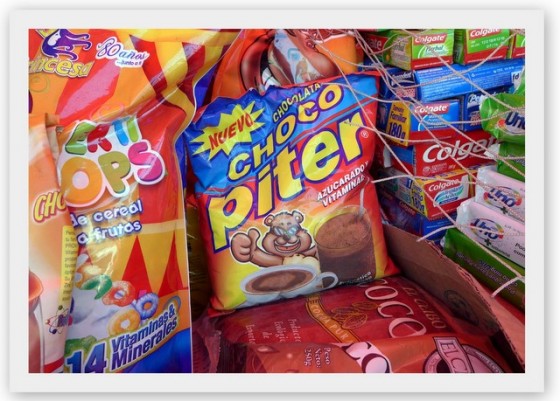

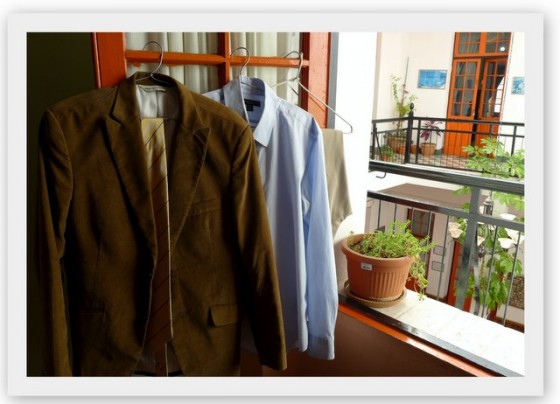

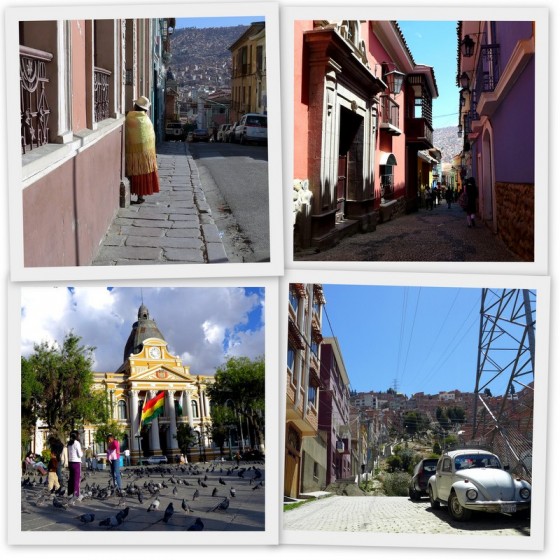
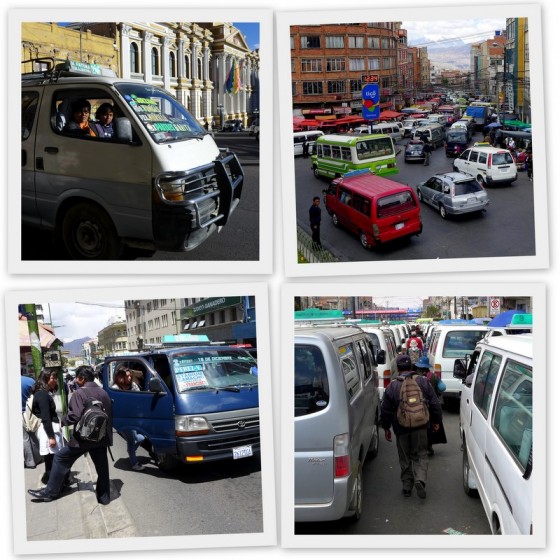
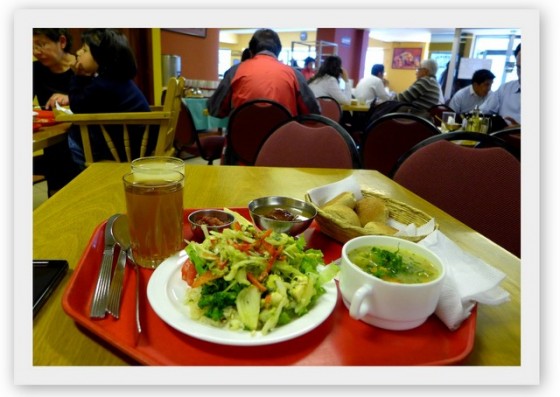
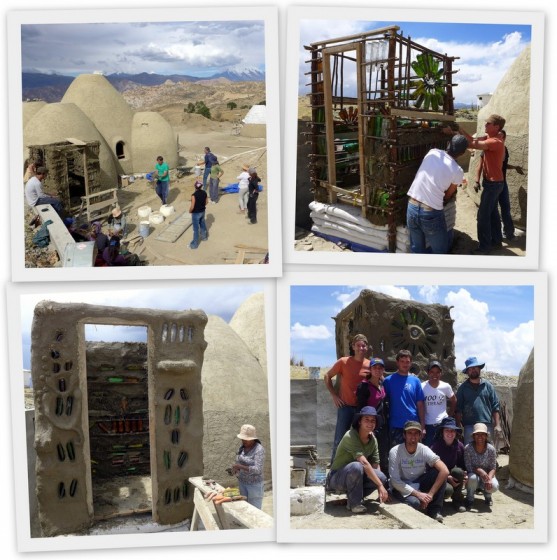
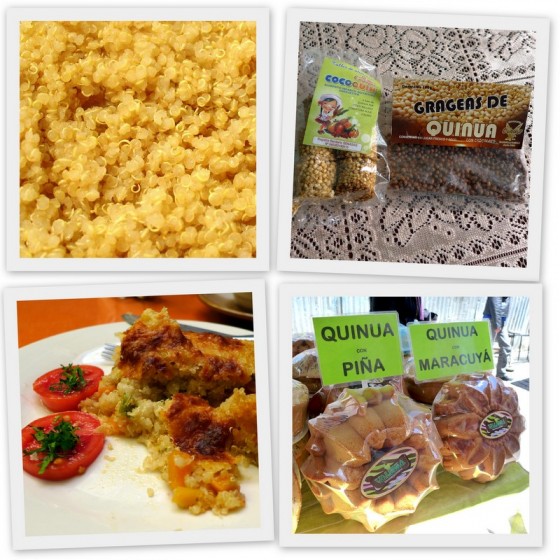
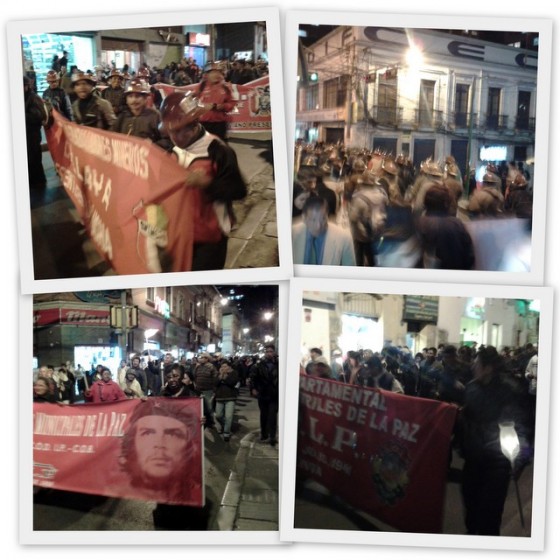
And where are the U.S. protesters against the power of the super-rich, for bringing our troops home now from Afghanistan, against workers’ wages free-fall?
Change will not come to us from elected officials? All change comes from within each individual and manifests outward . The miner’s and other workers’ protests give me hope. Love Mother er la San Miguel de Allende, MX
I agree, Mom. Popular protest has been absent in the U.S. for several decades, with some exceptions like the recent Occupy Wall Street. But where is that now?
At least we have the ballot, the Bolivians have only had true universal suffrage since 1952. No wonder they are accustomed to taking to the streets!
Thank you for providing us such a robust account of your time thus far in Bolivia! The glimpses into the people and the places you have encountered are truly beautiful. I will take your words with me …”It’s a simple cause-and-effect relationship: the more I slow down, the more time I have. And the more time I have, the more I slow down.” Truly good words to live by no matter where one is!! Stay safe and happy! Miss you! Ame
I’m with Amy. That passage spoke to me because I just joined a 4-week class called Waking up In the Midst of Our lives. We did several wonderful meditations in our first class. I am forced to slow down in SMA because of the cobble stones and steep hills. I’m still “too busy” with household, cooking, and computer tasks. I’d rather be reading this great blog outside in our jardin. I’ll get there. Peter’s Mom
Thanks so much for the comments, Amy! It’s really been a wonderful adventure so far… and relatively unstressed. Today, for example, I spent all morning on the terrace in the beautiful sunshine with mountains all around, reading the Sunday newspaper. Then an afternoon stroll with Paul to a plaza to have lunch under a palm tree at an open-air vegetarian festival. Finally an afternoon siesta. Not a lot “accomplished” but I feel happier than ever!
This is apparently how most Cochabambinos spend their Sundays… the stores were closed, the streets quiet, and people everywhere with friends and families together, being casual and paying attention to each other.
I suppose this is how I will spend most Sundays here and I am looking forward to it. I am so grateful to be living in splendid Cochabamba for the next couple months instead of just passing through.